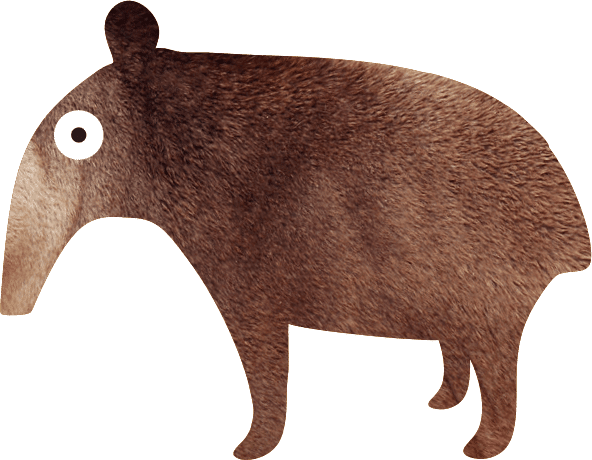Lowland tapir
Common Name: Lowland tapir
Scientific Name: Tapirus terrestris
Tapirs rest during the day and become active after sunset.
Tapirs have splayed feet which helps them to walk in soft, muddy ground.
These animals are great swimmers and can even dive! They use this ability to help them feed on aquatic plants as well as to escape from predators.
Tapirs wallow in mud. It is believed this helps them get rid of ticks, and the muddy coating it leaves helps protect them from insect bites.
Fast Facts
-
Status
Vulnerable
-
Size
Head-body 191-242cm; shoulder height: 83-118cm
-
Weight
180-300kg
-
Gestation
13 months
-
Young
1
-
Life span
35 years

In the wild
Tapirs mainly eat browse (the leaves and twigs of trees and shrubs). They also eat fruit and grasses. Palm fruits are an important part of their diet, especially during the dry season when there aren’t many other types of fruit available. Tapirs have a special long snout called a proboscis. The proboscis is prehensile, which means they can use it to grasp food. Tapirs can reach food up to three metres from the ground by standing on their hind feet and reaching up with their proboscis. Tapirs often go to salt licks to seek important minerals. Salt licks are places where salt deposits are found.
Tapirs are found in the lowland areas of many countries in northern and central South America, including Argentina, Bolivia, Brazil, Colombia and Ecuador. They live in a variety of habitats such as moist and swamp forests, dry and moist shrublands and grasslands, and a variety of wetlands.
Tapirs usually give birth to one calf, although twins are born very occasionally. Tapir calves are born with dark fur and pale spots or stripes which will have completely faded after five or six months. These markings help to camouflage them to protect them from predators. Calves are usually able to stand within a few hours of being born. In their first week of life they are left in a hidden spot while their mother goes off to feed. After ten days calves are able to follow their mothers about, and at three weeks of age they are able to swim. Calves are weaned by four months, but will stay with their mother until up to 18 months old.
The main predators of tapirs are jaguars and pumas. These cats will usually try to attack tapirs at night when they start to feed. Lowland tapirs have a ridge of fat running from their head to their back, covered with very thick skin and a bristly mane. This helps them to escape predators, which usually try to grab the tapir by the back of their neck.
The major threats facing tapirs include habitat loss due to deforestation, unsustainable hunting for their meat, and competition with cattle. Lowland tapirs are officially and legally protected in many of the countries they are found in, but unfortunately laws against hunting are very rarely enforced. These tapirs are found in many protected areas and are listed in CITES Appendix II, which means that international trade in the lowland tapir and its parts is restricted.